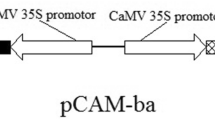Abstract.
Glycinebetaine is an important quaternary ammonium compound that is produced in response to salt and other osmotic stresses in many organisms. Its synthesis requires the catalysis of betaine aldehyde dehydrogenase encoded by BADH gene that converts betaine aldehyde into glycinebetaine in some halotolerant plants. We transformed the BADH gene, cloned from Atriplex hortensis and controlled by two 35S promoters of the cauliflower mosaic virus, into a salt-sensitive tomato cultivar, Bailichun, using Agrobacterium tumefaciens strain LBA4404 carrying a binary vector pBin438, and using a leaf regeneration system. Polymerase chain reaction and Southern hybridization analyses demonstrated that the BADH gene had integrated into the genome of tomato. Transgenic tomato plants showed significantly higher levels of mRNA and BADH enzyme activity than wild-type plants. Observations on rooting development and relative electronic conductivity suggested that the transgenic plants exhibited tolerance to salt stress, with these plants growing normally at salt concentrations up to 120 mM.
Similar content being viewed by others
Author information
Authors and Affiliations
Additional information
Electronic Publication
Rights and permissions
About this article
Cite this article
Jia, .GX., Zhu, .ZQ., Chang, .FQ. et al. Transformation of tomato with the BADH gene from Atriplex improves salt tolerance. Plant Cell Rep 21, 141–146 (2002). https://doi.org/10.1007/s00299-002-0489-1
Received:
Revised:
Accepted:
Issue Date:
DOI: https://doi.org/10.1007/s00299-002-0489-1




